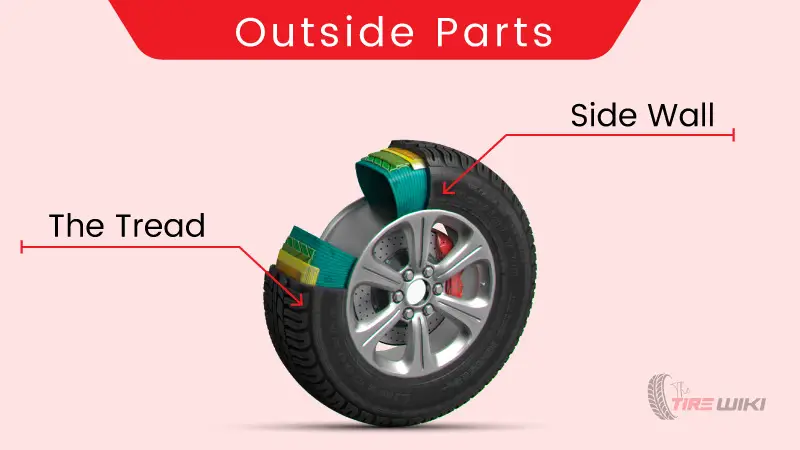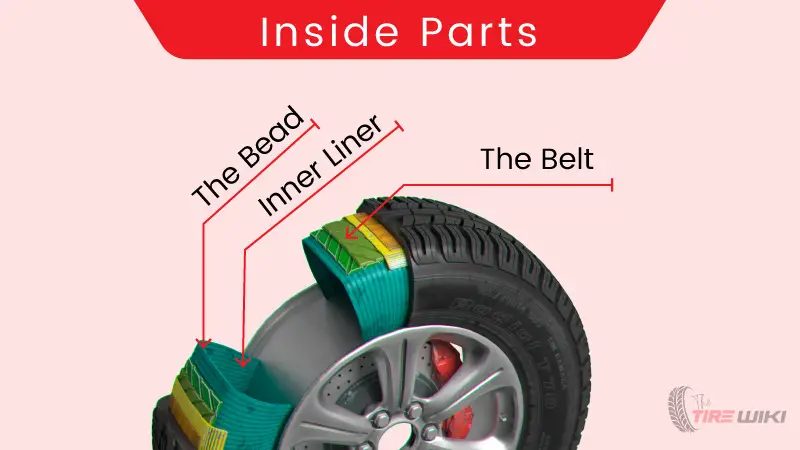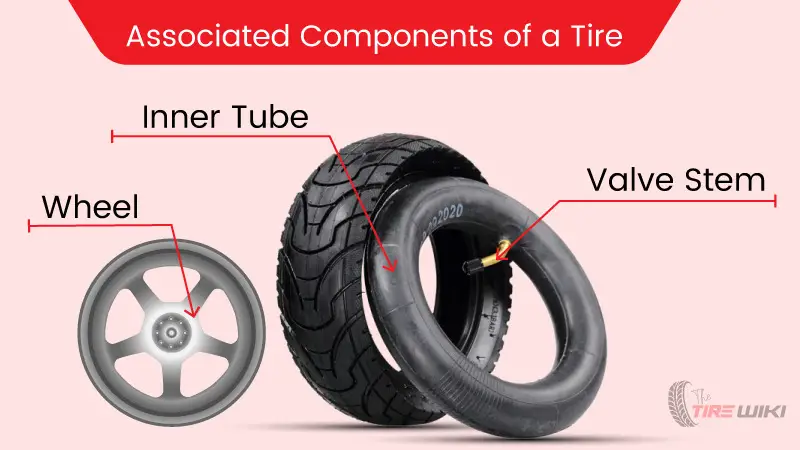A car’s tire is an essential component of a vehicle that plays a crucial role in supporting the vehicle’s load. While many of us are familiar with the basic design, only some understand the inner mechanisms and complex anatomy.
Whether you are a seasonal driver, a mechanic, or just someone who is interested in learning more about a tire’s inner workings, knowing the anatomy of a tire will give you confidence. Thus, you can confidently decide on your car’s safety and upkeep.
In this article, we discuss more about the parts of a tire.
Inside And Outside Parts of a Tire
From the beads to the tread, each part plays a crucial role in supporting the vehicle’s weight, transmitting braking force, maintaining direction, and absorbing shocks from the surface. We will start from the outside, the treads, and go into the inner parts like belt plies.
Keep reading to learn the details.
#1 – Outside Parts

The outer parts of the tire consist of the sidewall and tread. Each part plays an essential role in ensuring safety while you drive.
The Tread
Trade is one of the most important tire parts names. It refers to the upper surface above the sidewall that comes into contact with the road and is responsible for providing traction.
The trade part has a pattern on its surface called grooves. These grooves channel water away from the tire’s surface in wet conditions. They come in various designs depending on different driving conditions.
For example, the pattern of snow tires is designed to withstand snow. Thus, the pattern of snow tires is not the same as that of off-road tires.
Sidewall
As the name suggests, the right and left labeled parts of the tire, from the bead to the tread, are referred to as the sidewall. If you just glance at the tire’s side, you can see tire markings on the sidewall. In light of this, we can refer to the sidewall of a tire as representing tire markings.
Tire marking refers to numbers like P215/65 R15, which contain the basic information about the tire, such as tire size, load capacity, or speed index. For example, the width of this particular tire is 215 millimeters. We will talk about it in detail in a later part of this blog.
#2 – Inside Parts

Whereas the outer parts of a tire protect it from damage, the inner parts ensure stability.
Let’s talk about each of them.
The Beads
The bead refers to the tire parts that come into contact with the wheel’s rim. It is made of high tensile steel wear along with copper and brass and is responsible for keeping the tire in place on the wheel.
Inside the tire bead, there is another component called bead filler. It is made of rubber components and is responsible for stability in the lower sidewall. It helps tires withstand the vehicle’s weight and prevents tires from sliding.
Inner Liner
The inner liner is one of the essential parts of a tyre diagram and is the innermost layer of a tire. It is a synthetic rubber designed to keep or hold the air inside the tire. It also plays a crucial role in maintaining tire pressure and improving fuel economy.
The Belt
The belts are a layer of fabric that sits under the tread. The role of this part is to provide strength and puncture resistance. There can be more than one layer. The material it is made of depends on the tire’s application or its intended use.
#3 – Associated Components of a Tire

In addition to the inner and outer parts of the tire, it has some associated components, including a valve stem, inner tube, and the wheel in which the tire is mounted. Let’s describe how important each part is in maintaining overall stability.
The Valve Stem
The valve stem is a metal part of the tire that allows air to be added or removed from the tire using an air pump. Parts of a tire valve consist of other elements, including a valve stem body, core, and cap.
In simple language, when your tire needs air, it receives air through the valve stem. The valve stem is usually attached to the rim.
Inner Tube
Tire also comes with an inner tube. It is made from material that is impervious, such as elastic synthetic rubber. When air is inserted, it inflates and retains air pressure.
Wheel
The wheel is where the tire is mounted. It is not a part of the tire but an associated component on which the whole wheel shape is formed when the tire is mounted.
Finally, in addition to the parts we discussed earlier, some other associated parts include bead filler, belt edge cushion, rim strip, and cord. All parts of the tire work together to hold air within the tire walls and ensure safety.
The Material and Manufacturing Process of Modern Tires
Rubber is the primary material of the tire, in addition to other materials such as carbon black, reinforcing materials such as steel or nylon, and sulfur.
All the other materials are usually mixed with the rubber and then heated. Each chemical plays its role in producing a stable product.
Whereas some chemicals keep the tire flexible, reinforcing materials make it stable.
The manufacturing process of tires can vary depending on the type of tire and the manufacturer’s method.
However, the core process remains the same, irrespective of the type of tire you make. Here are the primary steps that are followed in the manufacturing process.
- Step 1: All the raw materials are mixed.
- Step 2: The mixed elements are processed to make it into a strip.
- Step 3: In this step, the strip is wrapped around to create the tire’s basic structure.
- Step 4: Heat and reinforce the tire with steel or nylon.
- Step 5: Once the tire is ready, the manufacturer tests the tire.
Different Types of Tires
The different tire types depend on the vehicle and the driving conditions. Here are some common types of tires available in the market.
Tires for sedans, minivans, and other utility vehicles
- All-season tires
- Touring tires
- Summer tires
- Performance tires
Tires for SUVs and Trucks
- Highway tires
- All-terrain tires or mud-terrain tires
- Rib tires
Other tires
- Spare tires
- Winter tires
- Summer Tires
- Eco-friendly tires
Related: 5 Key Differences Between 225 And 235 Tires In 2025
Understand Tire Dimension
If you look closely at the sidewall, you will see tire markings like P315/65 R15. With a short description, it’s easy to understand this marking. If we break it down into pieces, all the letters and numbers mean the following:
- The letter “P” at the beginning means the tire is intended for Passenger vehicles
- The first three-digit number in the tire size 315 refers to the tire width
- After the slash mark, the two-digit number indicates the aspect ratio
- R means Radial
- 15 is the diameter
Tire Maintenance and Safety
Maintenance is always better than cure. It also increases lifespan and safety. By following these tips, your car’s tire will remain safe and in good condition.
- Use the tire pressure gauge and check the tire pressure at least once a month or before a long trip.
- Over time, tread depth reduces. Check the depth. If it is less than the manufacturing recommendation, replace the tire.
- Make sure the tire is correctly aligned.
- Check your tire after every long trip and look closely for any sign of damage.
- Every vehicle has a towing capacity. You should not exceed the towing capacity of the vehicle.
- Last but not least, drive safely.
FAQs About Tire Parts
What is the metal part of a tire called?
The metal part of a tire is called the wheel rim or simply rim. It is the outer edge of the wheel that holds the tire in place. Rims are typically made of steel or aluminum alloy and provide structural support, ensuring the tire stays securely attached to the vehicle. They also play a role in maintaining proper tire pressure and alignment, contributing to overall vehicle performance and safety.
What part of a tire can be patched?
A tire can typically be patched on the tread area, which is the part that makes contact with the road. Small punctures or holes in the tread, usually up to 1/4 inch in diameter, can often be repaired with a patch. However, damage to the sidewall or shoulder of the tire cannot be safely patched due to structural integrity concerns and the risk of blowouts.
What part of tire can be plugged?
A tire can be plugged in the tread area, specifically in the central portion that contacts the road. Plugs are used to repair small punctures caused by nails, screws, or similar objects. However, plugs should not be used for sidewall damage, large holes, or cuts, as these areas require professional repair or tire replacement.
What is the air thing on a tire called?
The air thing on a tire is called a valve stem. It is a small tube used to inflate and deflate the tire, maintaining proper air pressure. The valve stem typically has a cap to keep out dirt and moisture and contains a Schrader valve (common in cars) or Presta valve (common in bikes) to control airflow. Properly functioning valve stems are essential for tire safety and performance.
How many parts are in a tyre?
A tire typically consists of several key parts: the tread, which provides grip; the sidewall, which offers structural support and flexibility; the bead, ensuring a secure fit to the wheel rim; the belts, reinforcing the tire for stability; and the inner liner, maintaining air pressure. These components work together to ensure safety, performance, and durability. The exact number of parts can vary based on tire type and design.
Are valve stems part of the tire?
Valve stems are not part of the tire itself but are essential components of the wheel assembly. They are attached to the rim and provide an airtight seal, allowing inflation and deflation of the tire. While they work in conjunction with the tire to maintain proper air pressure, they are separate parts that can be replaced independently if damaged or worn out.
Related Posts:
- 10 Best 235/80R16 Trailer Tires 16-Ply, 12-Ply, 10-Ply, 8-Ply
- 3 Best 35X12.50R20 All-Terrain Tires for Off-Road
- 2 Best All-Terrain Tires for 4Runner: Off-Road Performance
- Best Tires for Snow Plowing: Top 10 Picks 2025
- The 7 Best 215/85R16 Dually Tires – Top 7 Picks
- 7 Best Tires for Silverado 1500: Top Picks for Every Season
- 10 Best UTV Tires for Pavement: Top Picks for Smooth Rides
- 10 Best 30-Inch UTV Tires for Unmatched Off-Road Performance
